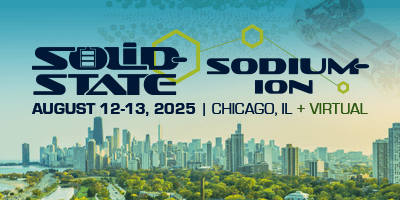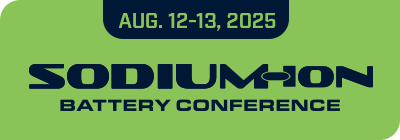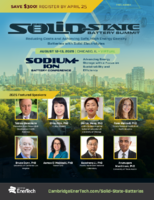Solid-State Battery Summit
고체 전해질의 사용에 의해 비용 절감과 안전한 고에너지 밀도 배터리를 실현
2025년 8월 12일-13일 CDT(미국 중부 표준시·서머타임)
Tuesday, August 12
7:00 amRegistration and Morning Coffee
APPLICATIONS & MARKET
Insights into Successful Scale-Up-A Possible Recipe
 Halle Cheeseman, PhD, Program Director, ARPA-E
Halle Cheeseman, PhD, Program Director, ARPA-E
Solid State Batteries are inevitable but how will the many valleys of death be traversed? Over the last 20 years, there have been few to no western companies achieving commercial success with a new battery technology. How can Solid State beat the trend? This presentation will highlight the problems and offer solutions. Topics will include: identifying a winning proposition, maximizing yield early, beachhead markets, and riding the wave.
Discovery of Recent Solid-State Battery Developments-Will They Hit Mass Production Sooner than Expected?
 Ines Miller, Team Lead Battery Cells, E Mobility, P3 Automotive GmbH
Ines Miller, Team Lead Battery Cells, E Mobility, P3 Automotive GmbH
Recent developments and announcements, especially from China, suggest that solid-state battery technology might be advancing faster than anticipated. Rumors indicate that leading players are already scaling production, with mass production targeted even before 2030. In this talk, we will deep dive into the technology’s maturity, assess industry leaders’ progress in production and industrialization, and compare developments and competitiveness in China, the EU, and the US.
Pathways to Commercialize Solid-State Battery Technology through Collaborations across the Value Chain
 Sumin Zhu, PhD, Co-Founder & CEO, Ampcera, Inc.
Sumin Zhu, PhD, Co-Founder & CEO, Ampcera, Inc.
The commercialization of solid-state battery technology presents both significant opportunities and challenges. This presentation explores the critical pathways for bringing solid-state batteries from the R&D phase to commercial launch. Focusing on the importance of strategic collaborations across the value chain, we discuss how partnerships between material and equipment suppliers, battery manufacturers, OEMs, and research institutions can accelerate technological advancements, reduce costs and time-to-market, and enhance scalability. By addressing key factors such as intellectual property management, supply chain integration, regulatory considerations, and joint development initiatives, this talk highlights how collaborative efforts can overcome existing technical and market barriers. Ultimately, it provides insights into the synergistic roles that each player in the value chain must adopt to ensure the successful commercialization of solid-state battery technology, paving the way for a sustainable energy future.
10:00 amGrand Opening Coffee Break in the Exhibit Hall with Poster Viewing (Sponsor Opportunity Available)
OEM PERSPECTIVES ON SOLID-STATE
Solid State Batteries: Progress in Solid Electrolytes and Needs
 Rana Mohtadi, PhD, Senior Principal Scientist, Materials Research, Toyota Research Institute of North America
Rana Mohtadi, PhD, Senior Principal Scientist, Materials Research, Toyota Research Institute of North America
Solid state electrolyte SSE materials hold the key to enabling highly efficient solid state battery technologies. Thus, the demonstration of SSEs capable of meeting the performance metrics demanded is of a paramount importance. Herein, we will provide an update related to progresses being made in the area of SSE material development.
Lithium Metal-A Unique Anode Worthy of Special Attention
 Tobias Glossmann, Principal Systems Engineer, HV Battery Research and Test Lab, Mercedes-Benz Research and Development North America
Tobias Glossmann, Principal Systems Engineer, HV Battery Research and Test Lab, Mercedes-Benz Research and Development North America
An increased number of battery types are expected to use Li-metal anode technology in the coming years. They are attractive for energy density and enable more choices of positive electrode materials. Stakeholders from industry and academia came together to identify open questions and serious challenges that must be addressed to enable successful integration. This talk will summarize these activities and highlight important issues to consider when testing Li-metal cells.
11:45 amSponsored Presentation (Opportunity Available)
12:15 pmEnjoy Lunch on Your Own
OEM PERSPECTIVES ON SOLID-STATE
Unlocking Silicon's Potential: Advanced Diagnostics in Solid-State Battery Development
 Owen Lu, PhD, Research Engineer, Ford Motor Company
Owen Lu, PhD, Research Engineer, Ford Motor Company
Silicon offers immense potential as an anode material in solid-state batteries (SSBs). However, significant challenges, such as substantial volume expansion and resultant structural degradation, must be addressed to pave the way for its commercialization. The combination of Electrochemical Impedance Spectroscopy (EIS) and Focused Ion Beam-Scanning Electron Microscopy (FIB-SEM) provides a comprehensive understanding of the electro-chemo-mechanical behavior of silicon-based SSBs, ultimately advancing the development of high-performance, durable SSBs.
Investigation of Structure-Diffusion Relationship in Halide SEs Using Atomistic Simulations
 Manas Likhit Holekevi Chandrappa, PhD, Materials Researcher, Nissan Advanced Technical Center, Silicon Valley
Manas Likhit Holekevi Chandrappa, PhD, Materials Researcher, Nissan Advanced Technical Center, Silicon Valley
 Masanobu Uchimura, Senior Manager, Nissan Advanced Technology Center Silicon Valley, Nissan North America Inc.
Masanobu Uchimura, Senior Manager, Nissan Advanced Technology Center Silicon Valley, Nissan North America Inc.
Halide SEs have surged in popularity as they offer a good balance of high ionic conductivity (>1 mS/cm), high voltage stability (>4 V), and mechanical properties. More recently, amorphous halide (including oxy-halide) SEs have been reported with ultra-high ionic conductivity of >10 mS/cm. In this talk, we demonstrate how we leverage cutting-edge atomistic simulation tools to investigate and elucidate the conduction mechanisms in crystalline and amorphous halide SEs.
 Perspective on Warm Isostatic Pressing for Mass Production of Solid-State Batteries
Perspective on Warm Isostatic Pressing for Mass Production of Solid-State Batteries
 Timo Rabe, Bus Dev Mgr, Energy Storage, Quintus Technologies AB
Timo Rabe, Bus Dev Mgr, Energy Storage, Quintus Technologies AB
Processing equipment for scalable and effective lamination of Solid-State Battery (SSB) components and its integration is a bottleneck toward deployment. This presentation will discuss Isostatic Pressing (ISP) techniques, summarize studies on SSBs leveraging ISP and resulting impact on electrochemical performance, and provide a techno-economic analysis for implementing ISP at scale for SSBs.
3:00 pmSponsored Presentation (Opportunity Available)
3:15 pmRefreshment Break in the Exhibit Hall with Poster Viewing (Sponsorship Opportunity Available)
R&D ADVANCEMENTS IN SOLID-STATE BATTERIES
Quest for Scalable Sulfide-Based Solid-State Batteries
 Chisu Kim, PhD, Director of Research and Strategy, Hydro-Quebec
Chisu Kim, PhD, Director of Research and Strategy, Hydro-Quebec
This presentation will address the critical challenges of sulfide-based solid-state batteries at the material and process levels for their large-scale commercialization in coming years. New types of binders will be highlighted; these are being developed to improve the mechanical properties and electrochemical stability of the cathode, electrode, and electrolyte film, as well as to reduce the particle-to-particle interface resistances of lithium-ion transport.
Development of Fully Solid State Batteries Requiring Little or No External Pressure
 Steven Visco, PhD, CEO & CTO, PolyPlus Battery
Steven Visco, PhD, CEO & CTO, PolyPlus Battery
In January 2025, a devastating fire destroyed the 4,000 MWh Vistra energy storage facility near Monterey, California, burning for four days, highlighting the need for safer batteries. PolyPlus develops next generation batteries based on both oxide and sulfide solid electrolytes, and has demonstrated specific energies = 1500 Wh/kg for advanced 500 Ah batteries. In this presentation, we will address challenges and solutions to the development and fabrication of rechargeable solid-state and primary lithium metal batteries with exceptional performance. Each approach introduces its own unique challenges including lithium/solid-electrolyte interface, battery safety, manufacturing issues for solid-state batteries, and cost implications of novel approaches
4:45 pmNetworking Reception in the Exhibit Hall with Poster Viewing (Sponsor Opportunity Available)
5:45 pmConference Tutorials*
Please click here for tutorial descriptions: Tutorials *Separate registration required
7:15 pmClose of Day
Wednesday, August 13
7:30 amRegistration and Morning Coffee
R&D ADVANCEMENTS IN SOLID-STATE BATTERIES
Building a Completely Dry Solid-State Battery with a Silicon Anode
 Kevin Wujcik, PhD, CTO, R&D, Blue Current Inc.
Kevin Wujcik, PhD, CTO, R&D, Blue Current Inc.
Blue Current is developing fully dry solid-state batteries featuring silicon active material anodes and flexible composite electrolytes. The company is now scaling production of 2 Ah solid-state pouch cells at its pilot facility in Hayward, CA. In this presentation, Blue Current will provide a detailed exploration of its cell performance capabilities and an update regarding the company’s pouch-cell commercialization roadmap.
Delivering on Our JDAs and A-Sample Results
 Adrian Tylim, Head Business Development North America, Blue Solutions
Adrian Tylim, Head Business Development North America, Blue Solutions
Leading the solid-state battery industry, Blue Solutions has over a decade of experience successfully deploying its technology in thousands of electric vehicles. Our fourth-generation chemistry and cells, leveraging ultra-thin lithium-metal anodes and a range of cathode options, have resulted in key joint development agreements with OEMs. This year, we'll unveil our progress through the release of A-samples.
9:00 amSponsored Presentation (Opportunity Available)
9:30 amCoffee Break in the Exhibit Hall with Poster Viewing (Sponsorship Opportunity Available)
Better Texture for Better Battery-New Perspective on All Solid-State Cells
 Shirley Meng, PhD, Director, Energy Storage Research Alliance (ESRA), Argonne National Laboratory; The Liew Family Professor, The University of Chicago
Shirley Meng, PhD, Director, Energy Storage Research Alliance (ESRA), Argonne National Laboratory; The Liew Family Professor, The University of Chicago
Soft metals like lithium and sodium have excellent properties for being batteries’ negative electrodes, with lithium considered as an ultimate anode material for future high-energy rechargeable batteries. There is a gap in understanding the grain orientation, also known as the texture, how such factor impacts the rechargeable metal battery performance. In this talk, I will explain how texturing can enable better performance in all solid state batteries.
Updates in Lithium-Metal Battery Technology
 Cheng-Chieh Chao, PhD, Vice President, R&D, Quantumscape
Cheng-Chieh Chao, PhD, Vice President, R&D, Quantumscape
Today’s lithium-ion batteries fall short of meeting consumers’ needs in the automotive, consumer electronics, and stationary storage sectors. Solid-state lithium-metal batteries have the potential to help bridge this gap, particularly in the automotive sector, because the technology is designed to enable longer range, faster charging and enhanced safety compared to conventional lithium-ion batteries. QuantumScape’s Vice President of Cathode, Cheng-Chieh Chao, will highlight recent developments in solid-state lithium-metal battery technology for automotive applications and discuss innovative commercialization strategies, like using licensing models, that are gearing up to get this technology on the road as quickly and cost effectively as possible.
11:30 amEnjoy Lunch on Your Own
R&D ADVANCEMENTS IN SOLID-STATE BATTERIES
Are Solid-State Li-Metal Batteries Non-Flammable?
 Mickael Dollé, PhD, Professor, Department of Chemistry, Université de Montréal
Mickael Dollé, PhD, Professor, Department of Chemistry, Université de Montréal
All solid-state Li-metal batteries are the focus of extensive research activities given their perceived potential to meet the safety requirements of advanced applications. With the absence of liquids, these batteries are often considered safer and non-flammable. However, we will discuss a concerning area that has been largely overlooked regarding the exothermic reactivity of Li metal when in contact with standard cathode materials.
Control of Two Solid Electrolyte Interphases at the Negative Electrode of an Anode-Free All Solid-State Battery Based on Argyrodite Electrolyte
 David Mitlin, PhD, David Allen Cockrell Professor in Engineering, University of Texas Austin
David Mitlin, PhD, David Allen Cockrell Professor in Engineering, University of Texas Austin
Electrochemical stability of an anode-free all solid-state battery (AF-ASSB) based on argyrodite Li6PS5Cl (LPSCl) requires control of two distinct solid electrolyte interphases, SEI-1 and SEI-2. In fact, there are three active interfaces when an "empty" current collector is employed; lithium metal - SE interphase (SEI-1), lithium - current collector interface, and the collector - SE interphase (SEI-2) where copper sulfides are formed. A bilayer of 140 nm magnesium / 30 nm tungsten (Mg/W-Cu) controls these interfaces and allows for state-of-the-art electrochemical performance in half-cells and full cells. An AF-ASSB with NMC811 cathode achieves 150 cycles with Coulombic efficiency (CE) above 99.8%. With a high mass-loading cathode (8.6 mAh cm-2), the AF-ASSB retains 86.5% capacity after 45 cycles at 0.2C. During electrodeposition of Li, a gradient Li-Mg solid solution is formed, which reverses upon electrodissolution. This promotes conformal wetting/dewetting by the Li and stabilizes SEI-1 by lowering the thermodynamic driving force for SE reduction. The refractory W underlayer is required to prevent ongoing formation of SEI-2, which also drives electrochemical degradation. A mechanistic explanation for the observed Li segregation within the alloying LixMg layer is provided through mesoscale modelling, considering the role of diffusivity differences and of interfacial stress.
Performance Without Pressure: Solid-state Batteries for Efficient Product Integration
 Gregory Hitz, PhD, Founder & CTO, Ion Storage Systems
Gregory Hitz, PhD, Founder & CTO, Ion Storage Systems
ION’s solid-state electrolyte bilayer structure enables an anodeless Li-metal cell that operates without compression and provides better safety, energy density, and manufacturability. ION's cell provides a drop-in upgrade for Li-ion that will empower new possibilities in consumer electronics, defense, and EV market applications. ION will share its recent achievements in cell performance and manufacturability, as well as updates on customer sample delivery.
3:00 pmRefreshment Break in the Exhibit Hall with Last Chance for Poster Viewing (Sponsorship Opportunity Available)
SOLID-STATE BATTERY SAFETY
Advanced Solid-State Air Batteries to Decarbonize Transportation
 Mohammad Asadi, PhD, Assistant Professor, Illinois Institute of Technology
Mohammad Asadi, PhD, Assistant Professor, Illinois Institute of Technology
In this summit, I will present our recently developed cost-effective and energy-efficient solid-state air-battery technologies with superior energy density as a potential to defossilize heavy transport sectors such as heavy ground transportation, aviation, and maritime shipping.
Ceramic-Polymer Composite Electrolytes for Solid-State Batteries
 Chelsea Chen, PhD, Polymer Physicist, Oak Ridge National Laboratory
Chelsea Chen, PhD, Polymer Physicist, Oak Ridge National Laboratory
We develop a composite electrolyte consisting of a single-ion-conducting polymeric host with high entropy Li-garnet particles as fillers. The composite electrolyte boasts high ionic conductivity (~10-4 S/cm at room temperature) and a high Li+ transference number (0.75). Furthermore, the composite electrolyte shows stability with Li-metal anodes and greatly improved dendrite resistance due to a desirable combination of ion-transport and rheological properties.
How Safe Are Solid-State Batteries? Identifying Hazards with a Bottom-Up Approach
 Nathan Johnson, PhD, Senior Member of Technical Staff, Sandia National Laboratories
Nathan Johnson, PhD, Senior Member of Technical Staff, Sandia National Laboratories
Previously, Solid State Batteries (SSBs) have boasted improved safety from the replacement of flammable liquid electrolyte with non-flammable solids. However, this assumption of inherent improved safety has come into question. The early identification of unique hazards and failure mechanisms in prospective materials is critical for preventing safety-related setbacks for effective commercialization. In this work, the hazards of promising SSBs are assessed through a multi-scale approach beginning at the materials level.
4:30 pmClose of Summit
* 주최측 사정에 따라 사전 예고없이 프로그램이 변경될 수 있습니다.










